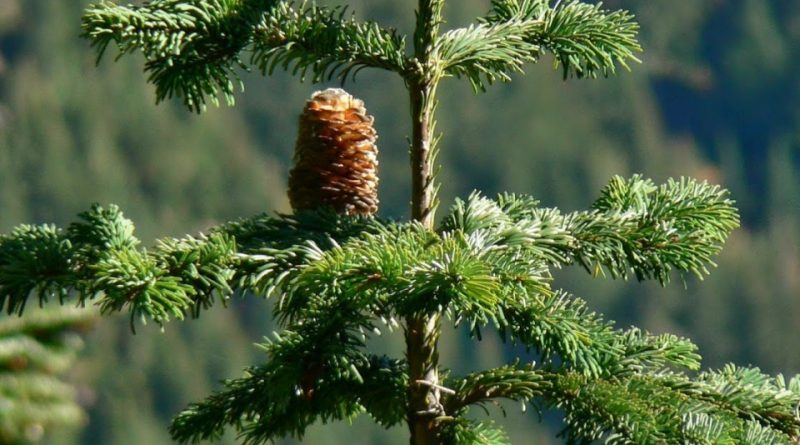Abies amabilis
Abies amabilis
Pacific silver fir (Abies amabilis (Douglas ex Loudon) J. Forbes, 1839) is an arboreal species belonging to the Pinaceae family.
Systematics –
From the systematic point of view it belongs to the Eukaryota Domain, Kingdom Plantae, Pinophyta Division, Pinopsida Class, Pinales Order, Pinaceae Family and therefore to the Genus Abies and to the A. amabilis Species.
The terms are synonymous:
– Picea amabilis Douglas ex Loudon;
– Pinus amabilis (Douglas ex Loudon) Parl .;
– Abies grandis var. densifolia Engelm ..
Etymology –
The term Abies comes from the Latin Abies, a classical Latin name (Virgil, Egloghe) from the Sanskrit root abh to gush, referring to the resin.
The epithet Amabilis comes from the Latin and means lovable, graceful.
Geographical Distribution and Habitat –
Pacific silver fir is a species native to the Pacific coastal region of North America, in an area between the south of Alaska and California.
The species is found in a vast area extending from south-eastern Alaska, through western British Columbia to Canada, and finally to the western part of Washington and Oregon and to the northwestern part of California.
It is present at altitudes ranging from sea level to 1,000 m, in the northernmost part of its vast area, above 1,000 m from Oregon to the south.
Its habitat is that of well-drained soils of humid and cool coastal forests, characterized by a maritime climate with a long and snowy winter.
It is found in forest formations both exclusive and mixed, in combination with other species such as:
Abies lasiocarpa, Abies magnifica, Abies procera, Abies grandis, Picea sitchensis, Pseudotsuga menziesii, Tsuga heterophylla, Tsuga mertensiana and Cupressus nootkatensis. Furthermore, the association with Vaccinium alaskaense is typical of the undergrowth shrubs.
Description –
The Abies amabilis is a large tree that can reach up to 75 meters with trunks up to 2.5 meters in diameter, with bark, light gray, smooth and with resinous bubbles in young plants that with age splits into reddish scales.
The gait is slender and conical which with the passing of time tends to become cylindrical, with a flat top.
The main branches are short and rigid and branch off from the trunk at a right angle; the secondary branches are brown in color and are arranged opposite each other.
It has needle-like leaves, shiny dark green in the upper part and silvery white in the lower part; they are up to 2.5 cm long, upwards and very dense to cover the twigs.
It has purple, roundish gems, less than one cm long, with pearls that cover them short, pubescent, triangular and with a sharp apex.
The male strobili are initially red and then become yellow-reddish.
The female strobili are gray-violet in color and then become brown, cylindrical-ovoid; they are resinous, up to 10 cm long and up to 5 cm wide, with 2 cm flakes, pubescent.
It has brown seeds, about 12 mm long, with pink or brown wings of one cm. At germination, the cotyledons are 4-7.
Cultivation –
The Abies amabilis is a plant that must be grown in well-drained soils with a cold climate even if it tolerates exposures both in full sun and in partial shade; and on average tolerant of high temperatures but develops better at low temperatures. It is however a fir tree that has greater climatic requirements than others. in places of origin, in addition to having a very large range, coinciding with many protected areas, it has good reproduction capabilities.
The soil must have a slightly acidic pH.
This plant, except in the early times after the plant is satisfied with rainwater.
As with other fir trees, no special fertilizers are necessary except in the planting phase with organic substances to be distributed directly in the hole.
As for pruning Abies amabilis does not need to be pruned, with rare exceptions and for fortuitous factors.
Uses and Traditions –
The pacific silver fir is used for its wood, clear and easily workable for the manufacture of plywood, veneers, foundations and coatings, and in the pulp industry. Less used instead as an ornamental plant as it is a species, as mentioned, with high climatic requirements.
It is recalled that the resin of this plant, as for other firs, is used for its balsamic and invigorating virtues.
It is a moderately toxic plant for animals. Fir oils can irritate the mouth and stomach of cats and dogs and can induce nausea and vomiting.
The needles if ingested could irritate the gastrointestinal tract and in the most serious cases cause perforations.
Unfortunately over the centuries the excessive exploitation of its wood has led to a drastic decrease of these plants. Today its use is regulated on sustainable levels; pests and fires pose risks only at the local level.
In any case, the Abies amabilis is classified as a species at the lowest risk of extinction in the IUCN Red List.
Preparation Mode –
In addition to those mentioned, there are no special food or pharmaceutical uses for this plant.
Guido Bissanti
Sources
– Acta Plantarum – Flora of the Italian Regions.
– Wikipedia, the free encyclopedia.
– Treben M., 2000. Health from the Pharmacy of the Lord, Advice and experiences with medicinal herbs, Ennsthaler Editore
– Pignatti S., 1982. Flora of Italy, Edagricole, Bologna.
– Conti F., Abbate G., Alessandrini A., Blasi C. (edited by), 2005. An annotated checklist of the Italian vascular flora, Palombi Editore.
Attention: Pharmaceutical applications and food uses are indicated for informational purposes only, do not in any way represent a medical prescription; therefore no responsibility is assumed for their use for curative, aesthetic or food purposes.


